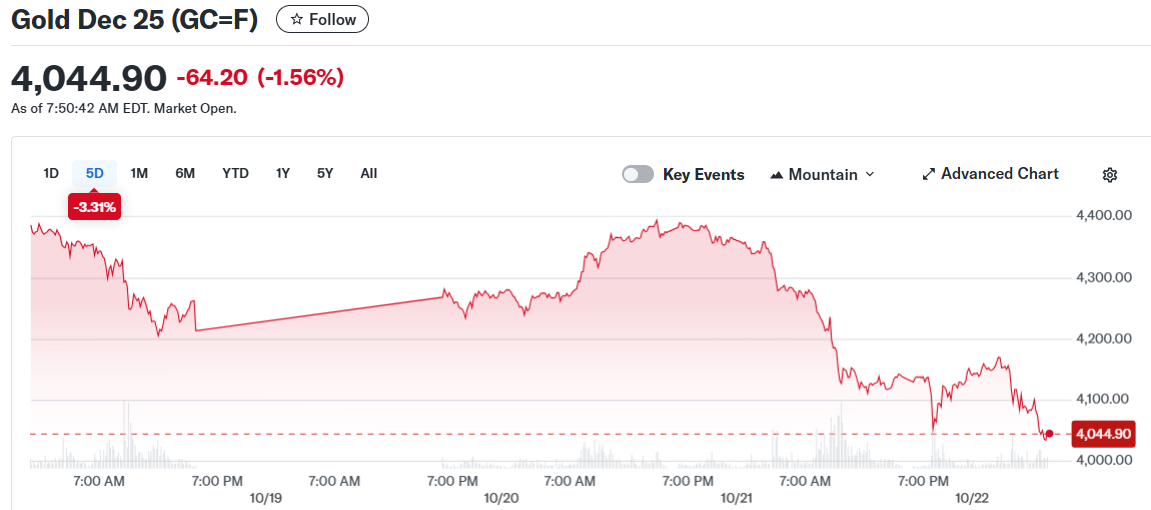Gold’s Record Rally Hits Wall as Prices Tumble Most Since 2013
TLDR
- Gold futures dropped 0.4% to $4,092 an ounce on Wednesday, following a 5.7% plunge on Tuesday—the largest single-day decline in over 12 years
- Newmont mining shares fell 2.9% in early trading after dropping 9% the previous session as investors took profits from gold’s record-breaking rally
- Despite the selloff, gold remains up about 55% this year and is on track for its best annual performance since 1979
- Citigroup downgraded its gold recommendation and expects further consolidation around $4,000 an ounce in coming weeks due to stretched positioning
- The pullback came after retail investor enthusiasm and technical indicators showed gold prices had become overbought since early September
Gold prices continued falling on Wednesday after experiencing the biggest one-day selloff in more than a decade. The most actively traded gold futures contract declined 0.4% to $4,092 an ounce in early trading.
 Gold Dec 25 (GC=F)
Gold Dec 25 (GC=F)
Tuesday’s session saw gold plummet 5.7%, with spot prices tumbling as much as 6.3% at one point. The sharp decline caught many investors off guard given gold’s strong performance throughout 2025.
Newmont, one of the world’s largest gold mining companies, saw its shares drop 2.9% ahead of Wednesday’s opening bell. The mining stock had already fallen 9% during Tuesday’s trading session.
Deutsche Bank macro strategist Henry Allen noted the selloff was unusual because it happened despite declining bond yields. Lower bond yields typically support gold prices since the metal doesn’t pay interest.
Technical Factors Drive Selling
Market analysts point to technical selling as the primary cause of the decline. Gold prices have been trading in overbought territory since the beginning of September according to Standard Chartered.
Suki Cooper, head of commodities research at Standard Chartered, said the bank expects gold to regain momentum next year. Technical indicators had been signaling that gold’s rally was overstretched after breaking successive records throughout 2025.
The precious metal is still up approximately 55% for the year. The rapid advance began in mid-August, driven by multiple factors including Federal Reserve rate cut expectations.
Retail Investors and Market Positioning
Retail investors have played a larger role in gold’s recent rally after sitting on the sidelines earlier in the year. Social media videos showed long queues of buyers outside bullion retailers as enthusiasm for the debasement trade grew.
Options volume on gold-backed ETFs and futures contracts surged as retail investors sought exposure to the metal. These instruments allow investors to make large bets on gold’s value without purchasing physical metal.
Citigroup cut its overweight gold recommendation following Tuesday’s selloff. The bank cited concerns about stretched positioning among investors.
Citigroup strategists expect further consolidation around $4,000 an ounce in the coming weeks. They noted that prices had “run ahead of the ‘debasement’ story.”
Central banks have continued buying gold to diversify away from the U.S. dollar. This demand has provided support for prices throughout the year alongside inflows into exchange-traded funds.
The U.S. government shutdown has prevented the release of weekly positioning data from the Commodity Futures Trading Commission. This report normally shows how hedge funds and money managers are positioned in gold and silver futures.
Without this data, speculators may be more likely to build abnormally large positions. Traders rely on the CFTC report as a valuable tool for understanding market sentiment.
Other precious metals also experienced declines on Tuesday but showed mixed performance on Wednesday. Silver rose 0.5% to $47.92 an ounce while platinum gained 1.1% to $1,536 an ounce.
President Trump indicated on Tuesday that an upcoming meeting with Chinese President Xi Jinping could yield a trade deal. However, he also acknowledged the talks may not happen.
The post Gold’s Record Rally Hits Wall as Prices Tumble Most Since 2013 appeared first on Blockonomi.
You May Also Like

8.18 Million Solana Committed on CME as SOL Options Prepare to Go Live

Why XRP Price Has Dropped Despite Massive Success This Week
